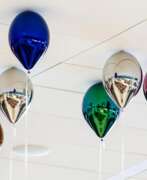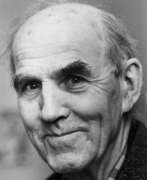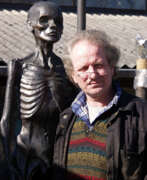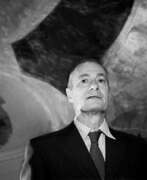Denmark Contemporary art


Jan Leth Aagensen was a Danish artist. He made his name as a lithographer and later became known for his sculptures.
Jan Leth's formal training took place at the Royal Danish Academy of Fine Arts under Professor Søren Hjort Nielsen from 1965 to 1969. His first exhibition took place in 1961 at Kunstnernes Forårudstilling (Spring Artists' Exhibition). He is a member of various art groups: Decembristerne, Kunstnersamfundet og Foreningen Danske Grafikere, the Association of the Royal Danish Academy of Fine Arts and the Association of Danish Painters Engravers.
Jan Leth has participated in various solo and group exhibitions, presenting paintings, sculptures, drawings, and installations in Denmark and abroad. He has received many honours and grants throughout his life. The Danish State gave him a lifelong economic grant in 1998. His work is represented in gallery collections in Denmark and internationally.


Kurt Ard was a Danish illustrator, painter and printmaker. He became internationally famous for his narrative cover artwork published in popular magazines of the 1950s-1970s, including the Family Journal, the Saturday Evening Post and Reader’s Digest. Ard started his career at various smaller newspapers and worked in the same realistic tradition as his role model, illustrator and painter, Norman Rockwell. During WW II, Kurt struggled to fulfill commission orders. His painting and his reputation and success grew steadily in the post war years. His illustrations soon appeared in major European publications, and he subsequently achieved international fame. Over the course of his career, Ard has sold more than 1000 illustrations to the best magazines in Europe, and to American publications such as McCalls, Good Housekeeping and Redbook. Today, Kurt continues to create exceptional figurative, landscape and seascape paintings with uncompromising authenticity , capturing the charm, beauty and power of these diverse subjects. His work is especially notable for its brilliant light and precise detail.


Peter Brandes is a Danish painter, sculptor, ceramic artist and photographer.
Brandes' art is abstract and often in brown colours. He had his breakthrough as artist in the beginning of the 1980s. He has, inter alia, done artwork on Roskilde Domkirke and mosaic (colored glass) windows in a church at Nordkap and the church Village of Hope, south of Los Angeles. In 1998, he created the enormous Roskilde Jars which stand outside the main Roskilde Railway Station.
Brandes is self-taught and his art circles around themes from Christianity. Ancient Greek mythology has also inspired his art. Brandes has illustrated a number of books, for example Homer’s Iliad. A great part of Brandes' ceramic works are inspired by ancient Greek art and mythology.


Nanna Ditzel was a Danish furniture designer.
She studied at the Danish School of Arts and Crafts and the Royal Danish Academy of Fine Arts in Copenhagen with painter Victor Isbrand, Orla Mølgaard-Nielsen, Peter Hvidt and Kaare Klint graduating in 1946. Her works include making cabinets, jewelry, tableware and textiles. She also made jewelry designs for Georg Jensen and furniture for Frederica.


Olafur Eliasson is an Icelandic–Danish artist known for sculptured and large-scale installation art employing elemental materials such as light, water, and air temperature to enhance the viewer's experience. In 1995 he established Studio Olafur Eliasson in Berlin, a laboratory for spatial research. In 2014, Eliasson and his long-time collaborator, German architect Sebastian Behmann founded Studio Other Spaces, an office for architecture and art. Olafur represented Denmark at the 50th Venice Biennale in 2003 and later that year installed The Weather Project, which has been described as «a milestone in contemporary art», in the Turbine Hall of Tate Modern, London.




Zacharias Heinesen is a Faroese painter. He is the son of the writer and artist William Heinesen.
His works include oil paintings, watercolour paintings, drawings, woodcuts, lithographs and paper collages.
His paintings were featured on a series of stamps in June 2001.


Robert Jacobsen, full name Robert Julius Tommy Jacobsen is a Danish painter and abstract sculptor. Jacobsen is a self-taught sculptor.
He became acquainted with modernist artists and created massive structures in granite and sandstone under the titles "Mythical Creatures", "Dolls". During his stay in France, his work included sculptures in cast iron.
Jacobsen was also a professor at the Munich Academy of Fine Arts and the Royal Danish Academy of Arts.


Sergej Jensen is a contemporary Danish artist, known for his sparse paintings that highlight the formal intricacies of a painting’s structure. Through muted hues and eclectic mark-making, Jensen probes the subtly of materials. His work is perhaps best understood in the context of other Minimalist painters like Michael Krebber, Robert Ryman, and Blinky Palermo. Jensen has described his practice as "Painting without paint." His surfaces and materials are handled in a manner that the most delicate scrubbed and patinated areas act as expressive marks.
Sergej Jensen’s work draws on a wide range of materials and formal references. Primarily known for his textile works, his lyrical compositions incorporate a variety of fabrics, from burlap and linen to silk and wool.


Jakob Kolding is a Danish and German artist and stage designer.
He graduated from the Royal Danish Academy of Fine Arts and lives and works in Berlin, Germany.
Using sources ranging from historical canons of fine art, literature and theater to pop music, hip-hop, science fiction, urban imagery and contemporary culture, Kolding has created his own visual vocabulary in the collage technique. Building layer upon layer, he brings to life a world as complex as it is aesthetically beautiful. And Kolding's scenography transforms into three-dimensional collages, expanding throughout the space in which they inhabit, creating an entire world.


Margrethe Alexandrine Thorhildur Ingrid (Danish: Margrethe Alexandrine Þórhildur Ingrid) is Her Majesty Queen Margrethe II of Denmark.
Since 1970 she has been active in several artistic expressions: painting, church textiles, watercolours, prints, book illustrations, decoupage, set design and embroidery. Many of these artistic works have been shown at exhibitions in Denmark and abroad.
Margrethe II's works are represented in art museums such as the Statens Museum for Kunst (Danish National Gallery), Aarhus Art Museum, ARoS and Køge Art Gallery Sketch Collection (sketches for church textiles).


Richard Mortensen was a Danish painter.
During the Second World War, Mortensen's works reflected the violence of Europe. After the death of his wife Sonja Hauberg, in 1947 moved to Paris remaining there until 1964. Together with Robert Jacobsen, Mortensen became connected to the Galerie Denise René in Paris, which became famous for concrete art. His later works are concrete works of art characterised by large, clear, bright colour surfaces. After his return to Denmark in 1964, he received a professorship at the Royal Danish Academy of Art in Copenhagen, which he held until 1980.
Mortensen was awarded the Edvard Munch Prize (1946), the Kandinsky prize (1950), the Prince Eugen Medal (1967) and the Thorvaldsen Medal (1968).


Verner Panton was considered one of Denmark's most influential 20th-century furniture and interior designers. During his career, he created innovative and futuristic designs in a variety of materials, especially plastics, and in vibrant and exotic colors. His style was very 1960s but regained popularity at the end of the 20th century. As of 2004, Panton's best-known furniture models are still in production (at Vitra, among others).


Alev Ebüzziya Siesbye is a Turkish-Danish ceramic artist. Siesbye designed ceramic wares for the ceramic companies Royal Copenhagen and Rosenthal AG. In 2009, Siesbye was awarded the Chevalier de l'Ordre des Arts et des Lettres for her ceramic designs.


Sergey Yevgenievich Svyatchenko (Ukr. Сергій Євгенович Святченко) is a Danish artist, architect and photographer of Ukrainian origin. He is a representative of the New Wave.
Sergey Svyatchenko has worked on a number of commercial projects, including collaborations with fashion brands such as Hugo Boss and Comme des Garçons.
In his work, Svyatchenko combines elements of photography, painting and collage to create layered and textured compositions. He often uses found materials such as vintage photographs, postcards and magazines and his work is characterised by the use of bold colours, strong graphic forms and surreal juxtapositions.
Sergey Svyatchenko is also a writer and curator. He has published several books on art and photography and has curated exhibitions of contemporary art in Denmark and Ukraine. He is the founder of the Ukrainian Art Foundation, which aims to promote Ukrainian art and culture internationally.


Danh Vo, birth name Võ Trung Kỳ Danh, is a Vietnamese-born painter and sculptor who lives and works in Berlin and Mexico City.
As a child, he left Vietnam as a refugee in 1979 with his family and moved to Europe. His family settled in Denmark, where they were granted political asylum and citizenship. Vo later studied at the Royal Danish Academy of Fine Arts in Copenhagen and graduated from the Städelschule in Frankfurt.
His work is at the intersection of art, world history and personal diary. Vo's works draw on the facts of many individual biographies, including his own, as well as aspects of political history and social memory, to analyze the various forces that influence our lives in both explicit and unexplored ways. Danh Vo creates sculptures, installations, photographs and works on paper.


Björn Wiinblad was a Danish artist and designer. He was best known for his work in ceramics, but he also worked in a variety of other media, including glass, textiles, and graphics.
Wiinblad studied at the Royal Danish Academy of Fine Arts in Copenhagen before beginning his career as a freelance artist and designer. In the 1950s, he gained international recognition for his work in ceramics, which was characterized by his use of bright colors, whimsical patterns, and intricate details.
Wiinblad's ceramic pieces were often functional, such as plates, vases, and bowls, but he also created large-scale ceramic murals and sculptures. His work was heavily influenced by fairy tales, mythology, and the arts and crafts movement.
In addition to his work in ceramics, Wiinblad also designed textiles, glassware, and furniture, and he was an accomplished graphic artist. He created illustrations for books and magazines, as well as posters, advertisements, and even a set of postage stamps for the Danish postal service.
Wiinblad's work has been exhibited in museums and galleries around the world, and he has been the recipient of numerous awards and honors for his contributions to the arts. His designs continue to be popular today, and his ceramics and other works can be found in the collections of many museums and private collectors.











































































